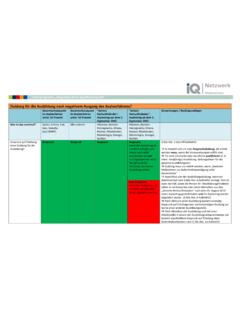Transcription of ZIMBABWE COUNTRY REPORT FOR THE 2014 …
1 1 ZIMBABWE COUNTRY REPORT FOR THE 2014 ministerial conference ON youth employment How to Improve, Trough Skills Development and Job Creation, Access of Africa s youth to the World of Work Abidjan, C te d Ivoire, 21-23 July, 2014 2 SKILLS TRAINING AND THE employment SITUATION OF YOUNG PEOPLE IN ZIMBABWE AN ANALYSIS OF THE TECHNICAL AND VOCATIONAL EDUCATION AND TRAINING (TVET) AND THE employment SITUATION OF YOUNG PEOPLE IN ZIMBABWE COMPILED BY ELIAS MURINDA, ACTING DIRECTOR youth DEVELOPMENT MINISTRY OF youth , INDIGENISATION AND ECONOMIC EMPOWERMENT APRIL 2014 3 TABLE OF CONTENTS List of Tables and Figures 3 List of Acronyms and Abbreviations 4 EXECUTIVE SUMMARY 5 1. INTRODUCTION 7 2. ZIMBABWE SITUATION ANALYSIS 8 Geography 8 Economy 8 Population 8 youth Population 8 youth employment and Entrepreneurship 9 Main Source of Livelihood for youth 9 3.
2 BASIC INFORMATION ON THE employment SITUATION OF YOUNG PEOPLE IN ZIMBABWE 10 4. BASIC INFORMATION ON THE LABOUR MARKET 12 5. DIFFICULTIES EXPERIENCED BY YOUNG PEOPLE IN GAINING ACCESS TO employment 17 The youth Unemployment Challenge 17 Causes of youth Unemployment 6. PLANNED OR IMPLEMENTED MEASURES CONCERNING TVSD 18 National Skills Development Policy Framework 21 The National youth Policy 21 Skills for youth Empowerment and Rural development 22 Vocational Training and Training for Enterprise programme 23 The Integrated Skills Outreach Programme (ISOP) 23 7. MEASURES TO PROMOTE JOB CREATION 25 ZIMBABWE youth employment Network (ZIYEN) 25 ZIMBABWE National employment Policy Framework (ZNEPF) 25 The National youth Fund 26 ZIMBABWE Agenda for Sustainable Socio-Economic Transformation (ZIM-Asset) 26 8.
3 SUCCESSFUL youth EMPOWERMENT PROJECT: SKILLS FOR youth EMPOWERMENT AND RURAL DEVELOPMENT 28 Objectives 28 Stakeholders and Implementation Structures 28 Main Achievements to Date 29 Prospects for Scaling up 29 9. CONCLUSION 30 REFERENCES 30 4 List of Tables and Figures Table 1: youth Unemployment and Vocational Education Training Situation by Sex 10 Table 2: Percent Distribution of Currently Employed Population aged 15 years and above by Industrial Sector and Sex 12 Table 3: Percent Distribution of Economically Active Population of ZIMBABWE aged 15 years and above by Urban/Rural Sector and Sex 13 Table 4: Percent Distribution of Currently Employed Population aged 15 years and above by Type of employment and Age Group 15 Figure 1: Broad Unemployment Rate by Level of Education and Sex in ZIMBABWE 17 5 List of Acronyms and Abbreviations AIDS Acquired Immune Deficiency Syndrome CBZ Commercial Bank of ZIMBABWE CABS Central African Building Society DANIDA Danish International Development Agency GOV Government of ZIMBABWE HIV Human Immuno Virus ICQN Inter- COUNTRY Quality Node ILO International Labour Organisation ISOP Integrated Skills Outreach programme LFCLS labour Force and Child Labour Survey MHTE Ministry of Higher and Tertiary Education MYIEE Ministry of youth , Indigenisation and Economic Empowerment NEETs Not in Education.
4 employment or Training NSC National Steering Committee NSDP National Skills Development Policy NGOs Non-Governmental Organisations QIA Quality Improvements in Informal Apprenticeship SMEs Small to Medium-Scale Enterprises SNV Netherlands Development Organisation TFE Training for Enterprise TREE Training for Rural Economic Empowerment TVET Technical and Vocational Education and Training TVSD Technical and Vocational Skills Development UNWTO United Nations World Tourism Organisations VTCs Vocational Training Centres ZIM-ASSET ZIMBABWE Agenda for Sustainable Socio-Economic Transformation ZIYEN ZIMBABWE youth employment Network ZNEPF ZIMBABWE National employment Policy Framework 6 EXECUTIVE SUMMARY According to the ZIMBABWE 2012 population census, ZIMBABWE has a young population.
5 Of the total population of 13 061 239, 77% consist of children and youth below 35 years of age. youth aged 15-34 years number 4 702 046 which constitutes 36% of the national population and those aged between 15 -24 years are 20%. The youth aged 15-34 years constitute 56% of the economically active population. Unemployment is one of the major challenges confronting the young people in ZIMBABWE today. Available data indicates that despite being in the majority, the young people are the hardest hit by unemployment. The 2012 Population Census data shows that the youth aged 15-34 years constitute 84% of the unemployed population and those aged 15-24 years constitute 55%. The statistics also indicate that the highest concentration of 31% of the unemployed is between the ages of 20 and 24 years.
6 There is also a gendered dimension to youth unemployment. There are higher levels of unemployment among female youths despite there being more females than males in the population. The ZIMBABWE 2011 Labour Force and Child Labour Survey (LFCLS) indicate that while the overall unemployment rate for youth aged 14-34 years is 15%, the majority, (87%) of the employed youth aged 15-34 years are considered to be in informal employment ; 9% in formal employment and 4% in unclassifiable employment . Despite the expansion of the education and training system at all levels after independence in the public and private sector and NGO sectors, one of the major challenges experienced by young people in gaining access to employment is lack of skills. The 2011 (LFCLS) showed that 91% of the population employed in the informal sector had no skills.
7 The current Technical, Vocational, Education Training (TVET) system is inadequate to meet the skills training and employment needs of the young people. The number of young people currently enrolled in TVET institutions and in apprenticeships is a negligible proportion of the out-of school youth who require skills for employment and industry growth. Other constraining factors include the mismatch between the skills being developed by the training system and what is needed in the labour market, the mismatch between the technology used in institutions of learning and industry and the general economic decline that has affected the labour absorption capacity of industry. A number of policies and programmes have been developed and implemented by Government in order to address the economic empowerment needs of Zimbabwean youth through skills development and employment creation as well as sustain and build economic growth in the COUNTRY .
8 These include among others; the drafting of the National Skills Development Policy (still in progress), the review of the National 7 youth Policy, review of the Vocational Training programme to focus on Training for Enterprise, and the Indigenisation and Economic Empowerment programme. Other policy measures and programmes that have been developed by Government to promote job creation especially for the youth include among others; the development of the ZIMBABWE youth employment Network (ZIYEN), the formulation of the National employment Policy Framework (ZNEPF), establishment of the youth Development Fund, establishment of youth Economic Zones, the Indigenisation and Economic Empowerment programme and the formulation of the ZIMBABWE Agenda for Sustainable Socio-Economic Transformation (ZIM-ASSET).
9 As the Government consolidates implementation of the National employment Policy Framework, and the finalisation of the National Skills Development Policy, in line with the ZIMBABWE youth employment Network (ZIYEN) and the ZIMBABWE Agenda for Sustainable Socio-Economic Transformation (ZIM-ASSET), ZIMBABWE will benefit immensely from cooperation and pooling of resources, experiences and sharing best practices with other countries. The nation therefore looks forward to establishing as well as strengthening existing partnerships, with other countries in the area of Skills Development for youth employment , Entrepreneurship and Industry Growth. 8 1. INTRODUCTION This REPORT presents an analysis of the Technical, Vocational Education and Training (TVET) and the employment situation of young people in ZIMBABWE .
10 It looks at the general employment situation of the youth , the difficulties they experience in gaining access to employment and the various policy measures and programmes that government has been implementing in order to address the economic empowerment needs of the youth through skills development and employment creation as well as sustain and build economic growth in the COUNTRY . The REPORT is also part of the COUNTRY s background paper in preparation for the Inter- COUNTRY Quality Node for Technical and Vocational Skills Development (ICQN/TVSD) Ministers conference on youth employment in Africa which will take place in Abidjan, Cote d Ivoire from 20-22 July 2014 whose main objectives among others are to; share countries experiences and best practices in facilitating young people s access to employment , identify common challenges pertaining to technical and vocational skills development (TVSD) and the employment situation of young people in Africa and to develop and adopt regional strategies on TVET and youth employment .




